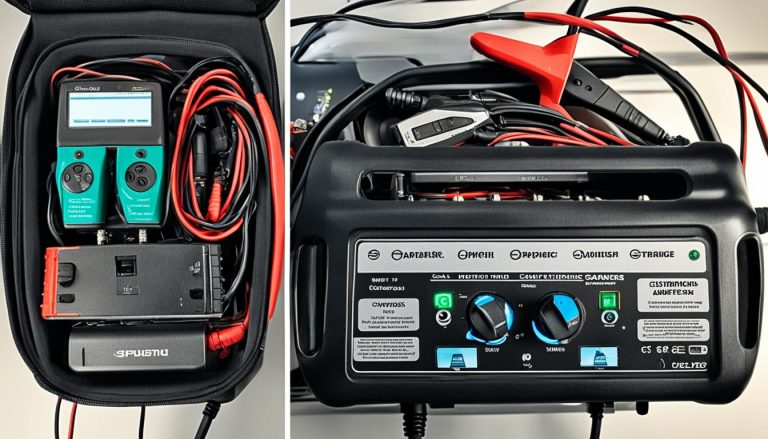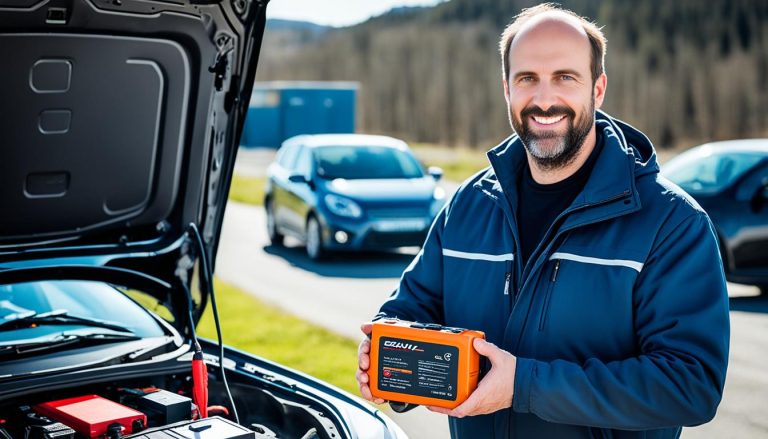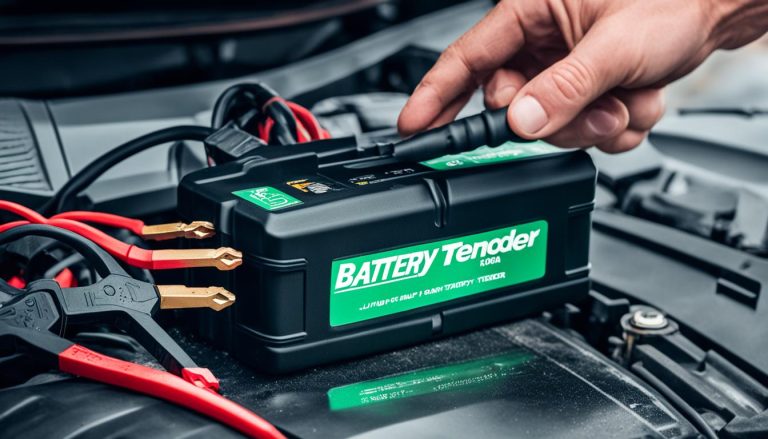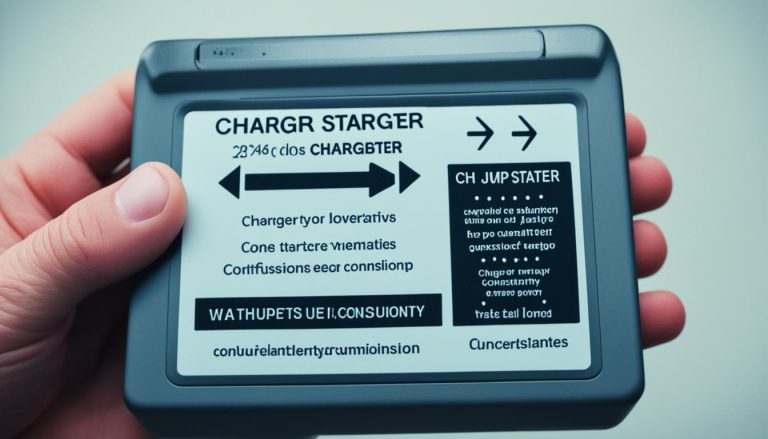How to Jump Start a Corroded Battery Safely
batterychargers.site and its partners may earn a commission if you purchase a product through one of our links
Finding yourself with a dead car battery can be a frustrating experience, especially if it has visible corrosion. But fear not, as understanding how to jump start a corroded battery is a handy skill that can get you back on the road in no time. Jump starting is a relatively quick process, typically taking about 15 minutes, but requires careful attention to detail to ensure your safety and the health of your vehicle. Before you begin, it’s critical to consult your vehicle’s owner’s manual for specific safety guidelines and the correct procedures to follow, as car batteries pack a lot of power and mishandling them could lead to injuries.
Remember, never attempt to jump start a corroded battery if it’s cracked, leaking, or visibly damaged. In cases like these, roadside assistance or professional help is your safest bet. If you’re set to proceed, gather the essentials like a quality pair of jumper cables, and perhaps a functioning car with a healthy battery or a reliable jump starter. Most importantly, keep the positive and negative clamps apart to prevent sparks or short circuits.
Key Takeaways
- Always consult your car’s manual for specific instructions on handling a corroded battery.
- Do not jump start if the battery is damaged—it’s not just unsafe, it can also be ineffective.
- Proper tools like jumper cables and a functioning car or jump box are necessary.
- Safety first: wear gloves and glasses, and ensure clamps never touch each other.
- Jump starting can be straightforward, but always prioritize care and precision throughout the process.
Understanding the Risks of a Corroded Battery
When it comes to vehicle maintenance, addressing a corroded battery is as crucial as any other mechanical repair. Recognizing the insidious nature of corrosion on your battery terminals is the first step toward ensuring the longevity and reliability of your car’s electrical system. Not only does it impede performance, but neglecting this issue could lead to costlier fixes down the line.
Identifying Signs of Corrosion
If you’re about to attempt a battery jump start with corrosion, it’s essential to spot the early signs. Typical indications include a white, blue, or greenish powdery buildup around the terminals. This substance represents the fallout of a chemical reaction involving hydrogen gas from your battery acid and, regrettably, it can mean trouble for starting your car.
Consequences of Ignoring Battery Corrosion
For those questioning whether to jump start battery with corrosion, be advised that this could be a temporary fix on a bigger issue. Corrosion can wreak havoc on your battery’s ability to conduct electricity, eventually draining its capability to hold a charge fully. Without intervention, the damage might extend to the car’s electrical system and lead to a complete battery failure, even if you manage to jump start it.
| Sign | Implication | Recommended Action |
|---|---|---|
| White/Greenish Powdery Substance | Corrosion caused by battery acid | Clean with baking soda/water solution or Diet Coke |
| Vehicle Electrical Issues | Possible damage from neglected corrosion | Inspect and replace cable or clamps if necessary |
| Battery Not Holding Charge | Corrosion may be hampering connections | Seek professional battery service or replacement |
Remember, attending to the corrosion before you jump start will not only enhance the battery’s functionality but will also ensure your safety. Although a jump start can be a quick solution for a dead battery, eliminating corrosion will fortify your car’s overall health, assuring that you’re not stranded with ignition troubles anytime soon.
Initial Preparations Before Jump-Starting
Embarking on the task to jump start a battery that corroded, your first step should always be thorough preparation. Safety and success hinge on ensuring you have the right tools and precautions in place. Let’s break down what you’ll need and the safety gear that is essential to protect yourself during this process.
Gathering Essential Tools
To effectively handle a corroded battery jump start, you should assemble a toolkit that comprises the following items:
- Jumper cables with clean and rust-free clamps
- A reliable jump starter or a second vehicle with a fully charged battery
- Wire brush for cleaning any minor corrosion from the terminals
- Baking soda solution to neutralize acid corrosion
- Clean cloth for wiping away debris and drying the battery terminals
It’s paramount to ensure that all tools are in good condition. For instance, inspect your jumper cables for any wear and tear that could compromise the jump start process.
Ensuring Safety with Proper Gear
Your safety during this procedure cannot be overstated. The following gear will help safeguard you from potential hazards:
| Safety Item | Function | Additional Notes |
|---|---|---|
| Rubber gloves | Electrical insulation | Prevents electrical shocks and protects hands from acid |
| Protective eyewear | Protects eyes from sparks and debris | Should be ANSI-approved for best protection |
| Fire extinguisher | Ready for electrical fires | Preferably a Class B (flammable liquids) or Class C (electrical) extinguisher |
Before commencing with the jump start, be certain that both vehicles (if using another vehicle) are turned off, with their gears in park or neutral and the parking brakes firmly set. Remember to keep jumper cable clips from touching each other or any metal to prevent sparks. It is these sparks that can cause a corroded battery to emit hydrogen gas, which is highly explosive.

Equipped with the right tools and safety equipment, you’re now ready to proceed with confidence. Next, we’ll tackle the actual jump-starting process and get you back on the road in no time.
Jump Starting a Corroded Battery: Step by Step
If your car battery has succumbed to corrosion, jump starting a corroded battery may seem daunting. However, following these precise steps, you can jump start a battery with corrosion safely and efficiently. Always remember that safety comes first, so ensure you’re wearing protective gear and that both vehicles are turned off before you begin.
- Step 1: Inspect the dead battery and the charger battery. Ensure both are free of serious damage and have adequate voltage.
- Step 2: Connect the red jumper cable clip to the positive terminal of the dead battery.
- Step 3: Attach the opposite red clip to the positive terminal of the functioning battery.
- Step 4: Secure the black jumper cable clip to the negative terminal of the good battery.
- Step 5: Clamp the other black clip to an unpainted metal surface on the car that has the dead battery to ground the connection.
- Step 6: Start the vehicle with the functional battery, letting it run for several minutes to charge the dead battery.
- Step 7: Attempt to start the car with the corroded battery. Once started, let it run to build up a charge.
- Step 8: Carefully remove the cables in the reverse order you put them on, ensuring the clips do not touch each other or the cars.
Below is a table summarizing the order of actions for easier reference:
| Action | Detail | Point of Attention |
|---|---|---|
| Inspect Batteries | Check for damages and voltage. | Do not proceed if batteries are cracked or leaking. |
| Connect Positive Clip | First red clip to dead battery’s positive terminal. | Ensure solid connection despite corrosion. |
| Connect Opposite Positive Clip | Second red clip to good battery’s positive terminal. | Both positive connections should be secure before proceeding. |
| Connect Negative Clip | First black clip to good battery’s negative terminal. | Avoid touching the car’s body with the clip to prevent shorting. |
| Ground Second Negative Clip | Second black clip to an unpainted metal on the car with dead battery. | Find an unpainted surface that’s not near the battery. |
| Start the Charger Car | Let it idle to charge the dead battery. | Wait a few minutes to allow charge transfer. |
| Try Starting Your Car | Start the car with the dead battery. | If it doesn’t start, recheck connections and wait longer. |
| Disconnect Cables | Remove clips in reverse order; avoid touching clamps. | Clamps touching can cause sparks or short circuits. |
Remember, jump starting your vehicle is a temporary fix. If you’ve had to jump start a battery with corrosion, it’s crucial to address the underlying issue afterwards to prevent recurrence.
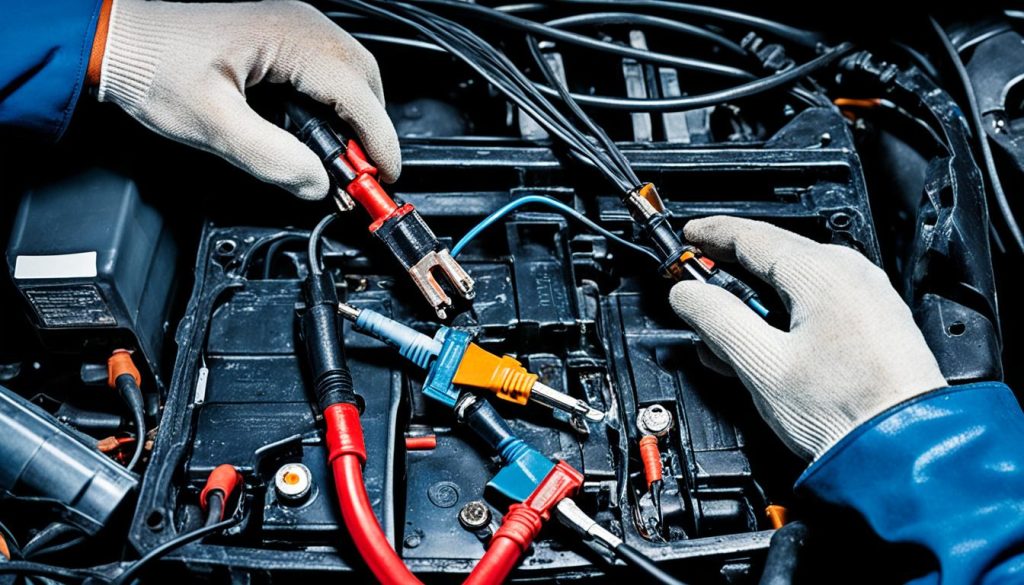
Post-Jump Start: Checking Battery Health
Successfully bringing your car to life with a jump start is only half the battle when dealing with a corroded battery. The real question is: How healthy is your battery after the jump? The condition of your vehicle’s battery post-jump can reveal a lot about its longevity and whether you need to leap at the chance to replace it. Let’s delve into the signs you should look for and the appropriate actions you should take.
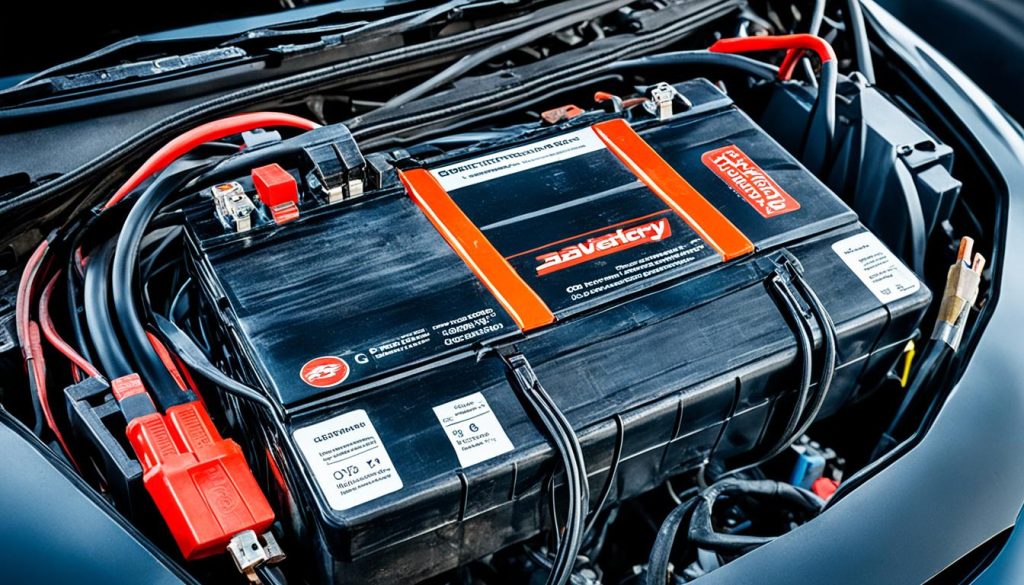
Assessing the Battery Post-Jump
After you jump start a corroded battery, take a moment to scrutinize the connections and terminal condition. You should be on the lookout for any persistent corrosion or damage that might suggest future problems. A healthy battery should have clean and secure connections, so if additional corrosion or issues surface, it calls for immediate attention.
When to Consider a Replacement
If your car exhibits trouble starting even after the jump, or if you find yourself frequently trying to jump start a battery with corrosion, there’s a likelihood your battery is on its last legs. Here’s a table to help decipher the signs indicating it’s time to look for a replacement.
| Sign | Indication | Action |
|---|---|---|
| Corrosion returns quickly after cleaning | Battery terminals deteriorating | Consider battery replacement |
| Car struggles to start post-jump | Possible deep-seated battery issue | Have a professional evaluate battery health |
| Dim lights or electrical fluctuations | Battery possibly failing to hold charge | Test battery and replace if required |
| Swollen or misshapen battery case | Signs of a compromised battery | Replace immediately to avoid safety risks |
Your vehicle is a crucial part of your daily life, and the last thing you want is to be stranded with a dead battery. Awareness and proactive battery health checks will always keep you one step ahead. And remember, when faced with the decision to replace, opting for a healthy, corrosion-free battery is the best investment for the longevity of your vehicle.
Troubleshooting Common Jump Start Problems
When facing the challenge of how to jump start a corroded battery, it’s essential to recognize that not every attempt will immediately roar your vehicle back to life. If, after your efforts to jump start a battery that corroded, the engine fails to turn over, it’s time to troubleshoot. First, make sure all connections between the alligator clips and battery terminals are secure. This is a common oversight and may be the reason your car remains silent post-jump.
What to Do If the Car Won’t Start Post-Jump
In the event that the car doesn’t start after the initial attempt, reassess the jumper cable attachments. Each clamp must be in firm contact with the appropriate terminal to ensure the transfer of power. Should these efforts still not yield results, the issue may lie deeper within the car’s electrical system or with the starter, requiring professional diagnostics.
Dealing with Persistent Corrosion After Jump Starting
Even after you’ve managed to jump start corroded car battery, you may notice the corrosion is stubborn. To maintain optimal performance and prevent future jump start issues, regular maintenance is key. Utilizing a battery memory saver while disconnecting the battery can safeguard your vehicle’s intricate electronics. If you discern any damage to the cables, do not hesitate to replace them. For cleaning, opt for a commercial cleaner or a mix of baking soda and warm water. Afterward, protect those terminals with a defense of dielectric grease or a protector—these will fend off corrosion and give you peace of mind. Yet, when faced with undercharging or overcharging symptoms, professional help should be your next course of action for a thorough electrical system check.
FAQ
How do you jump start a corroded battery safely?
To jump start a corroded battery safely, begin by inspecting the battery for significant damage and ensure there’s no risk of a short circuit. Then, clean the corrosion off the battery terminals using a mixture of baking soda and warm water, or even Diet Coke in a pinch, to establish a solid connection. Follow proper jump-starting procedures by connecting the appropriate jumper cable clips to the corresponding battery terminals and an unpainted metal surface on the vehicle with the dead battery. Start the donor vehicle, let the dead battery charge for a few minutes, and then try starting the car with the corroded battery. Always prioritize safety and wear protective gear such as gloves and eyewear. Consult your vehicle’s owner manual for specific instructions.
What are the signs of battery corrosion?
Signs of battery corrosion include white, blue, or greenish powdery substances around the battery terminals. Corrosion can indicate poor electrical conductivity and can inhibit the battery’s ability to charge and perform efficiently.
What could happen if I ignore battery corrosion?
Ignoring battery corrosion can lead to increased resistance in the electrical circuit, poor battery performance, and eventually complete battery failure. Severe corrosion can damage the vehicle’s electrical system and may result in costly repairs or a need for a battery replacement.
What should I gather before attempting to jump start a battery with corrosion?
Before attempting to jump start a battery with corrosion, gather jumper cables or a jump box/jump starter, a secondary vehicle with a functioning battery (if using jumper cables), protective gloves, eyewear, and basic cleaning supplies like a wire brush or terminal cleaning tool to remove corrosion from the battery terminals.
What safety gear should I use when jump starting a corroded battery?
When jump starting a corroded battery, it’s crucial to wear rubber gloves and safety goggles or glasses to protect yourself from the risk of acid spills, sparks that might ignite hydrogen gas, and corrosive debris.
Can you provide a step-by-step guide to jump starting a corroded battery?
Yes, to jump start a corroded battery: 1) Clean the battery terminals, 2) Connect the positive (red) jumper cable to the positive terminal on the dead battery, then to the positive terminal on the good battery, 3) Connect the negative (black) jumper cable to the negative terminal on the good battery, and the other end to an unpainted metal surface on the dead battery’s vehicle, 4) Start the donor vehicle and let it run for a few minutes, 5) Attempt to start the vehicle with the dead battery. If the car starts, leave it running and carefully disconnect cables in reverse order.
How can I assess my battery’s health after a jump start?
After jump starting your battery, drive your vehicle for at least 15-30 minutes to allow the alternator to recharge the battery. Then, you can check the battery’s voltage using a multimeter, inspect the terminals for leftover corrosion or damage, and ensure that the connections are secure and the battery is properly mounted. It may also be wise to have your battery professionally tested at an auto parts store or by a mechanic.
When should I consider replacing my car’s battery?
You should consider replacing your car’s battery if it frequently requires jump starts, shows persistent signs of significant corrosion, fails to hold a charge, or is approaching or has surpassed its expected lifespan, which is typically 3 to 5 years. Also, if your battery has sustained physical damage, such as a cracked case or leaks, it should be replaced immediately to avoid safety hazards.
What should I do if my car won’t start after a jump attempt?
If your car doesn’t start after a jump attempt, double-check the connections to ensure they are secure and the clamps are making proper contact with clean, corrosion-free battery terminals. If the connections are good but the car still won’t start, it could indicate issues with the starter, alternator, or other ignition system components that may require professional diagnostic and repair services.
How should I deal with persistent corrosion after jump starting?
To deal with persistent corrosion after jump starting, regularly clean the battery terminals using a terminal cleaner or a home solution like baking soda and water to prevent buildup. Apply a thin layer of dielectric grease or anti-corrosion pads to protect the terminals. Ensuring the charging system operates correctly is also critical, as overcharging or undercharging can cause corrosion. If corrosion persists, have the electrical system inspected by a professional mechanic.

